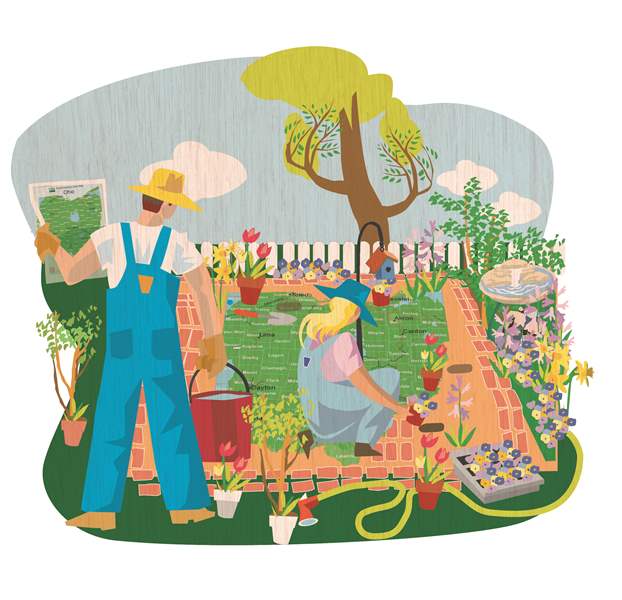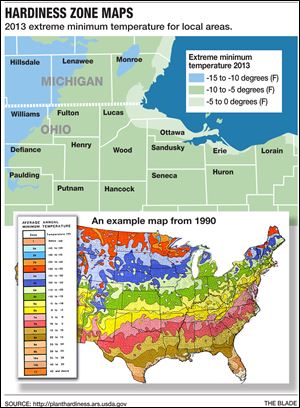
Revised USDA hardiness zone maps affect those planting in NW Ohio, SE Mich.
3/30/2014
BLADE ILLUSTRATION

When you’re “in the zone,” it’s always good to know what that zone is. And in northwest Ohio and southeast Michigan, the zone has changed.
Gardeners have long known our area to be Zone 5 in terms of plants that will thrive in our broad temperature range. The zone is often noted on seed packets and the plastic identification tags of perennial plants, those that live through the winter and return the following year.
Now an updated evaluation by the U.S. Department of Agriculture has declared northwest Ohio to be Zone 6, or more precisely, Zones 6a and 6b.
“It’s exact to a quarter-mile square,” Kim Kaplan, public affairs specialist for the Agricultural Research Service of USDA, said of the new map, a riot of wiggly pastel bands. It’s so detailed that gardeners can enter a Zip Code on the map’s online site and see which sub-zone they live in. The neighborhood near the Toledo Zoo in South Toledo is Zone 6a, for instance, while Old Orchard in West Toledo at Zone 6b is considered five degrees warmer.
The new map is the standard by which gardeners and growers can determine which plants are most likely to thrive in a location. It’s based on the minimum winter temperatures over 30 years, and divides the country into 13 bands, each representing 10 degrees of difference. The coldest parts of Alaska are Zone 1a; the warmest parts of Puerto Rico are Zone 13b.
The map provides a common language for gardeners, nurseries, and plant breeders to talk about plants (such as, Plant X should thrive in your Zone 5 yard), said Ms. Kaplan.
In some cases, crop insurance for farmers may require insured trees, such as an olive trees, to be in a zone appropriate for olive trees. Breeders of tropical plants — palms, indoor hibiscus, and brugmansia — want zones on their plant tags so people in northern zones will know when to bring the plants inside for wintering over.
Zone 6 flowering perennials might include some varieties of azaleas, coreopsis, and echinacea.

Most of Ohio is zoned 6a. A few slightly warmer areas are 6b (along Lake Erie, at the state’s southern border, and adjacent to the Ohio River). And a few spots that have higher elevations are 5b. It’s interesting to note the impact of warmer coastal zones: Traverse City, 300 miles northwest of Toledo and on a bay of Lake Michigan, is zoned 6a.
Perennial plants and woodies (bushes and trees) will thrive only in places mostly determined by temperature. A purple bougainvillea vine that rambles perennially over Florida trellises can grow in Toledo, but only for a summer before our winter zaps it. Some colorful varieties of echinacea, suitable for Zone 6, may survive, but after a year or two in our area may revert to their original color because of the cold.
Annual plants (they live a season), usually flowers sold by the flat, can’t survive our winters, but in far southern climes live perennially.
Gardening experts don’t advise filling one’s yard with Zone 6 perennials or trees.
Tom Demaline, with millions of plants in the ground, grows more perennials and woodies than anyone in Ohio at his Willoway Nurseries, Inc. in Avon, 25 miles west of Cleveland. He provided input for the map as a representative of the nursery industry but has decided not to change what he grows.
“We did not support the changes. The industry felt we were fine [in Zone 5],” said Mr. Demaline, adding that he’s sticking to the 1990 map and Ohio’s Zone 5 designation. Here’s why: Perennials, bushes, and trees usually cost significantly more than annuals, and when consumers are making an expensive landscape decision, it’s prudent to err on the conservative side, he said.
“A Zone 6 plant is going to get beat up in the winter,” said Mr. Demaline, second generation owner of Willoway. Whereas Zone 6 plants may have survived the mild winter of 2012-13, they would have struggled mightily with the winter 2013-14.
He noted the map does not include many conditions that affect hardiness, such as soil type. Heavy clay soil holds cold and moisture longer which can damage roots, whereas lighter, sandy soil will drain moisture away.
Another factor: What kind of weather did the plant experience in the previous year? In 1988, he said, severe drought and heat early in the growing season stunted plants, resulting in their playing catchup later in the summer after quenching rains kick-started their growth. Consequently, by late fall their growing cycles were out of whack and many plants suffered over the subsequent winter.
Mother Nature cares little about zone maps and she plays with a full deck. Wind, pollution, amount of snow, and winter sunshine make a difference. So do the size and health of a plant and its roots. An extreme cold snap in fall can hurt plants. So can unseasonably warm midwinter temps followed by cold, like that which wiped out Michigan’s 2013 fruit-tree crop. A dry spell in late autumn can cause stress. So can low winter humidity.
Sophisticated gardeners expect plant breeders to be completely reliable when testing new plants for zone hardiness, and there have been mistakes. A classic example was several years ago when a breeder introduced a ruby-red coreopsis with a tag saying it would be good in Zones 4 through 9. It was a big hit, but buyers in Zones 4 through 6 felt cheated when it didn’t make it through the winter. It’s now labeled as suitable for Zones 7 to 9.
Cindy Bench, co-owner of Bench Farms on State Rt. 2 in Curtice, said it’s good to hold off on buying newly bred plants. “We suggest the oldies and the goodies.”
She advises customers to treat Zone 6 plants as “tender perennials,” which are not likely to survive sub-zero temps. “I don’t totally trust Zone 6,” she added. After all, greenhouses want their customers to be successful.
It’s not unusual, however, for gardens to have microclimates which might tolerate a different zone. There may be “heat islands” near a south-facing building or a lot of concrete, on a leeward hill, or in an area the sun strikes all day. Likewise, it might be chillier in a low spot where cold air drops, on small hills, valleys, or unsheltered places.
“Nobody knows your garden better than you. There are always spots in your garden that are challenging,” said Ms. Kaplan. “I encourage people to see how close they are to an edge of a zone so they know how far they can push it. Maybe you’re only a half-degree off [from another zone].”
Amy Stone knows people who have grown Zone 7 plants locally. “They know that occasionally they’re going to be knocked back,” said Ms. Stone, educator at Lucas County’s OSU Extension office.
Despite our record-breaking winter, most plants should be OK, Ms. Stone said. “Perennials had a protective blanket of snow most of the season,” which kept the ground frozen, preventing roots from the damaging cycle of thawing and freezing.
ONLINE: Learn more about the Plant Hardiness Zone Map and check your Zip Code’s zone.
Contact Tahree Lane at: tlane@theblade.com or 419-724-6075.